
This paper was written as part of the 2005 Alaska Ocean Sciences Bowl high school competition. The conclusions in this report are solely those of the student authors.
The Effects of Global Warming on Barrow's Permafrost, Ice, and Community
Authors
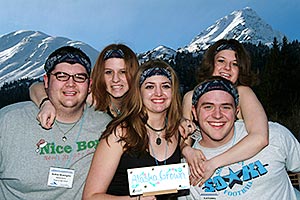
Table of Contents
Abstract
Global warming is effecting all of the world today and the affect is not a good one. Melting of ice caps, permafrost, and the overall warming of the world cause major problems all over; these problems affect everyone everywhere. Melting permafrost causes some of the most damage of any other factor that global warming affects. The heaving of permafrost damages roads, homes, and other buildings. Global warming also affects the melting of icepacks that many animal species rely on for shelter and/or hunting grounds. The loss of these icepacks causes a loss of subsistence food that the natives rely on for their main food source.
The problem we will address discusses the effect of melting permafrost on various forms of infrastructure. We focus on homes and roads because those affect many people personally. Solutions for the problems to home foundations include: building a crawl space, hiring a certified contractor, and finding more stable ground to build upon.
Solutions to the problem of upheaval in roads can be solved by: thermal piles with radiator tips and insulators such as rock and foam panels under roads. The only global solution available is to stop the green house emission now. The affect of halting emissions will not be seen until many years down the road, but if we don't stop them, then the global warming situation will never be solved.
The problem of global warming is not something that can be solved in a finger snap; it will take many years to fix the damage that we have done. Stopping the production of green house gases now will help greatly in the future.
Body of Paper
Introduction to Global Warming
Global warming is affecting the world at an alarming rate. The average temperatures of the world over the past 100 years have risen 0.6 ° C (about 1 ° F). The temperatures haven't just been rising at an average rate each year; they are increasing exponentially. The Arctic Climate Impact Assessment has proven that global warming is a danger that needs to be dealt with now and that the global warming crisis is aggravated even further by human activity (Berner etc. al., 2004).
The Arctic provides important natural resources to the rest of the world; these resources would be greatly affected by the global warming crisis (Berner etc. al., 2004). Areas where water is prevalent in its frozen state are affected the most by the rising temperatures (Armstrong). Arctic areas, including Alaska , have undergone the greatest temperature increases of any other area of the world. These temperatures have risen almost 6 E C, unlike rest of the world's average 0.6 degrees C increase.
The Arctic region affected by global warming includes the town of Barrow, Alaska. Barrow is considered to be the northern-most population in North America. There are about 4,400 people living in Barrow, 68 % being Alaskan natives. The Arctic Climate Impact Assessment has stated that Barrow's average temperatures have risen 2.5-3 ° C (4 E F) in the past thirty years alone (Handwerk, 2004). Global warming affects the indigenous peoples in many ways. The most obvious way that it affects them is through the food supply. Native Alaskans depend on hunting polar bear, walrus, seal, and caribou for subsistence and the preservation of their culture (Impacts of a Warming Arctic, 2004). Another fairly obvious way that the global warming affects the people of Alaska is through the melting of permafrost. Melting permafrost causes the sinking of homes, roads, and other infrastructures. The damage that the permafrost causes to roads alone costs the state almost 33 million dollars every year ( http://www.betterroads.com/ ).
Permafrost
Permafrost is soil that remains at or below 0 ° C continuously for at least two consecutive years. Instead of being defined by moisture content, overlying snow cover, or location, permafrost is defined and characterized by temperature. Permafrost consists of several frozen soils ranging from gravel to clay (Heidorn, 2004). The ability for the water to move within the permafrost enables the water to migrate and accumulate, forming large bodies of ice called ice lenses (Stidger, 2001).
There are two main types of permafrost. Continuous permafrost does not thaw at all during the year. Discontinuous permafrost's upper layers thaw during the warm seasons (Glossary, 2004). Distribution of different permafrost types is shown in Figure 1. The continuous is located farther north than the other two types because the temperatures are cooler. Discontinuous is not actually permafrost, but rather a frozen soil formation because is does not meet the exact definition of permafrost. Continuous permafrost has a top layer called the active layer which thaws every year. The melting of this ice-rich permafrost is extremely harmful to the earth's surface. This has raised concerns for the stability of roads and other various structures, especially in the areas located in the Northern region of North America (Impacts of permafrost).
The idea of whether or not the temperature change in Alaska is being caused by greenhouse emissions or are raising naturally has been a great debate between many scientists and politicians around the world. Currently, our government is remaining quite ignorant to the problems that global warming causes and the idea that we are the cause of this problem. The mean temperatures have risen by 5 °F in summer and 10 °F
in winter since the 1970's (Egan, 2002).
Organic material in thawing permafrost decays rapidly, releasing large quantities of carbon dioxide and methane. Methane and carbon dioxide are greenhouse gases, so the releasing of the gases makes the global warming worse and it will continue to get worse the more the permafrost thaws. If the melting of permafrost continues, the permafrost regions could change from a global carbon sink to a major source of carbon. This, in turn, would act as a positive feedback loop to global climate warming (Impacts of permafrost).
The melting of permafrost has caused many problems. Currently there has been an increase in wave amplitude. This is being caused by an increase in the amount of fetch off the sea. The larger waves are causing a problem for the whale hunters. The State of Alaska Bureau of Land Management found that over 50 percent of the native's diet depends upon whaling (http://www.ak.blm.gov/).
Another problem caused by permafrost melting is an increase in coastal erosion. A study done by the INSTAAR, CRIES, and AEROSPACE program at the University of Colorado found the costal erosion rates from 1948 to 2002. The study found that that the average costal erosion over the last five decades has been 20.6 meters. Figure 2 shows an overhead view of Barrow, the red line represents the coast in 1948. The study found the average coastal erosion rate in Southwest Barrow to be .48 meter per year, the average costal erosion rate in Barrow is .92 meter a year. Figure 3 shows the coast in 1948 in Southwest Barrow and Barrow and its yearly erosion rate.
Another dilemma occurring in Barrow is the increase of east and west return winds. A study done by Amanda Lynch and Ronald Brunner found the expected increase of return winds in the next 100 years. The current average return wind is 27 mile per hour. The projected return wind in 100 years is expected to be about 45 mile per hour. Figure 3 show the expected return winds.
Another problem that could occur is the increase chance of flooding. A study performed by Amanda Lynch and Ronald Brunner found that with the expect return wind increase and current coastal erosion rate that is a flood were to occur the damage would be significant. Figure 4 shows a house in Barrow being carried out to sea in the October flood of 1963.
Another set back to Barrow is the thawing of ice roads. Ice roads allow the oil companies to move about the tundra. Many people of the community of Barrow depend on jobs with these oil companies. A study performed by the Alaska State Department of Energy found the days that the ice roads could be used in 1970 to 2002. In 1970 the ice roads could be used for 200 days; in 2002 the ice roads could only be used for 103 days. That calculates to an average lose of three days a year.
Ice Melting
Rising temperatures have a dramatic impact on Arctic ice, which serves as a kind of "air conditioner" for the whole world. Since 1978, the area covered by Arctic sea ice has decreased by almost nine percent each decade (Handwerk, 2004). Arctic max sea ice has been melting earlier and earlier since the Little Ice Age, which began in the 1500's and ended in the 1850's (Glacier Change in the Upper Skagit River Basin). The total ice cover season is 16 days shorter then it was in 1850. The melt and has lengthened at a rate of 5.3 days (8%) per decade during that time. The western Arctic ice is warming at least twice as fast as the rest of the globe is. In the year of 2004, a 13.4% decline was reported. This is compared to the average of an 8% decline. The percentage of decline creates an issue because the decline usually recovers back to 8% after a higher decline year. The Arctic has not yet recovered from 2002's 15% decline. Every year in September, the sea ice decline is recorded. Mark Serreze of Snow and Ice Data Center: "We may soon reach a threshold beyond which the sea ice can no longer recover." (Woods, 1999). With the sea ice covering an area approximately the size of the U.S. , the reduction perdecade is equivalent to an area the size of Colorado and New Hampshire combined (Sturm et al., 2003). The reduction of these ice packs affects many animal species.
Animal Species Adapting and Integrating
Increased temperatures promote the invasion of foreign species and destroy the necessary habitats of native species. According to some scientists, the arctic invasion is already underway. Deeper seasonal thawing has led to migrating vegetation populations. Predictions show boreal forests moving as much as 550 kilometers northward over the next century (Climate Change, 2002), and the tundra is expected to shrink by almost two thirds, as it is replaced by invading plant species.
The diminished tundra will wreck havoc on grazing populations such as the musk oxen and the caribou. These species rely on the plentiful tundra vegetation to survive. Spring in the arctic has arrived so early that when the herds reach their calving grounds their main source of food has already gone to seed. The warming will also cause
the vegetation zones to shift significantly northward, reducing the amount of food available for the caribou. The decline in the vegetation could cause a large decline in the number of caribou and reindeer, thus threatening the well being of many native households,and undermining the cultural significance of hunting (Impacts of a Warming Arctic, 2004).
The expected affect of global warming on arctic ecosystems is astounding. Global warming will likely affect species at almost every level of the food chain, from plankton to polar bears. Arctic ecosystems already have a startlingly low number of species, and even small changes bring drastic results. According to Adam Markham, director of WWF's climate change campaign, "Arctic ecosystems are probably the most fragile and interdependent on earth" (Reindeer, 1996).
As temperatures rise, there is an increase in the thinning and retreating of Arctic ice packs, which provide habitat for many animal species. Habitat loss for some animals (such as: seal, walrus, and polar bear) results from increased ice melt.
Polar bears live and hunt on arctic sea ice. Polar bears feed almost exclusively on the seals that they hunt on the ice edge or through the pack ice itself. Studies show that the arctic ice has already decreased by about 40% (Maxwell, 1997) and future estimates go as high as 70% (Kirby, 2000). The summer ice-free period has lengthened as well. This leaves polar bears with less time on the sea ice to hunt for food and build up their body fat stores, and increased time on land where they must fast. Newborn bears are smaller than human babies, and blind. They require weeks of nurturing before they can leave their cave, but now there are several indications that an
increasing number of cubs, and even mothers, are found dead as they cannot breathe when the snow cave collapses due to global warming. If they do survive, the young are exposed to the frigid temperatures and they eventually die as well (Ice melting under the Feet of the Polar Bear). The losses of polar bear populations will not only affect the
people inhabiting the Arctic areas, but also significant consequences for the entire ecosystem that they occupy (Berner et. al., 2004).
Polar bears create a problem in Barrow. They lack the time needed to hunt on the ice, so they will travel into Barrow more and more. Although the locals of Barrow hunt the polar bears, they have to kill the ones that travel into their village. These murders take a lot of the sport out of the cultural hunts, and also create a mess, due to the fact that the bears dig through the community's trash.
Many seal species, such as the ringed, bearded, and ribbon seals, give birth to and nurse their young on the sea ice. The loss of the massive icepacks would force these seals to adapt to life on land. This stress would cause a decline in the seal populations and therefore affect the rest of the ecosystem as well (Berner et. al., 2004). This includes the native hunters who hunt the seal for subsistence as well as a cultural tradition.
Another organism, the bowhead whale, is important to the Inupiat Eskimos. These whales create a major cultural hunt among the community's natives. These whales travel yearly, along the northern coast of Alaska, to reach the Chuckchi and Beaufort Seas. In these areas the whales feed upon the booming populations of phytoplankton and zooplankton. With ice melting, the whales can travel further and further from shore. This allows them to reach many of the once isolated food stocks. This has given a rise to the bowhead whale's population.
Due to these melting ice caps, the local hunters are having many more troubles hunting the bowhead whale for subsistence and cultural tradition. One issue that contributes to this is that they can not reach the whales from shore any more. Another reason is the camps the hunters set up. They are on what was once a stable ice pack, but with an increase in ice melting, these ice packs that are camped upon collapse and crumble underneath the local hunters.
Barrow
The North Slope Borough provides many jobs for those living in the Barrow area. Many local businesses support oil field operations. These jobs are at great risk of being lost because of damage done to buildings and roads due to permafrost melting.
The thawing of permafrost has accelerated in recent decades, damaging buildings and infrastructures and causing public concern in many communities around the arctic slope. The existing infrastructures in northern regions are located in areas of high hazard thawing potential and will be at risk of damage and/or destruction if thawing continues on its current trend. Barrow is at risk for storm damage because the coast is eroding, causing many structures to become unsafe. The 4,500 inhabitants of Barrow are therefore at risk physically and economically if a strong storm occurs. Climatological factors that increase the probability of detrimental meteorological events include rising sea levels and thawing of permafrost. As permafrost thaws, many man-made structures are destroyed or damaged (Berner etc. al., 2004). Construction and maintenance of the infrastructure in the Arctic depends upon the climate.
A general contractor in Barrow noted that the depths at which pilings for structures must be set have increased by several feet over twenty years. Warming of permafrost before the actual thawing can greatly reduce the load capacity of pilings, creating significant problems for buildings and pipelines (Hinzman, 2004). Permafrost used to make a useful medium for foundation in these regions, but the melting is presently making it very dangerous to build a foundation in. This raises the challenge of preventing thawing of ice-rich permafrost in order to avoid slumping of buildings, pipelines, and dirt roadway (Berner/Hinzman, 2004).
Solutions to the Problem
There is no local solution to the global warming problem, but the community can take on alternate energy sources to do their part in the reduction of emissions.
Barrow currently uses natural gas.
Alternate energy sources:
1.) Solar Power – In Barrow, more solar energy falls on the roof of a house over a year than is needed to heat that house for the year.
2.) Wind Power – Wind power would be highly effective because the average wind speed in Barrow is 12.8 mph. Some windmills generate electricity atless than 5 cents/kWh. For a wind mill to work effectively the average wind speed of an area must be between 8 and 14 mph. Barrow's average wind speed is 12.8 mph, so Barrow would be a prime spot for this wind program.
3.) Larger Surf – Whaling is a mainstay of Barrow's Inupiaq Eskimos, and is becoming more dangerous. Bigger waves – small boats less viable on open water, harder to enter near shore (Charles Wohlforth, 2004). To help ease the problems of larger surf we would recommend a harbor for easier boat launching.
4.) Invading Species Moving Inland – "In a similar fashion, the red fox is heading north and can now be found in Arctic regions where winters have become less severe. That's bad news for the cold-hardy arctic fox, because it can't compete with its larger, more aggressive cousin." (www.wired.com)
ADF&G can monitor invading species, and their impact on food sources and competition with the indigenous arctic animals. Possible solutions after monitoring, depending on data: eliminate (animal control), relocation, rehabilitation programs, erosion.
Over the last 50 years, the average shore displacement was 20.6 meters, with an annual loss of 0.48 meters of the Barrow shoreline. To help ease the erosion of the banks, which can lead to flooding and loss of coast we recommend that the town of Barrow create an erosion protection program, similar to the Kenai Peninsula's, but adjusted for Barrow's individual needs.
5.) In order to decrease or stop global warming, the whole world will have to agree to two actions, mitigation and adaptation, that have been suggested by the ACIA for adjusting the globe's warming trend. Mitigation would involve the world's countries agreeing to reduce greenhouse gas emissions. Adaptation involves adapting to the plans implemented with mitigation, and would probably cause more economically stable countries to contribute more to less economically stable countries (Berner Et al, 2004). One idea for implementing mitigation would be for economically stable countries to agree and sign on to the Kyoto Protocol, which requires countries to reduce their greenhouse gas emissions (The Kyoto Protocol).
The warming of the Arctic regions affects everyone. It is our duty to help reduce the amount of global warming that takes place, and the only way we can do this is to stop production of green house gases now. If we wait to stop these emissions, it will take even longer for the world to heal itself.
Figures
Figure 1.
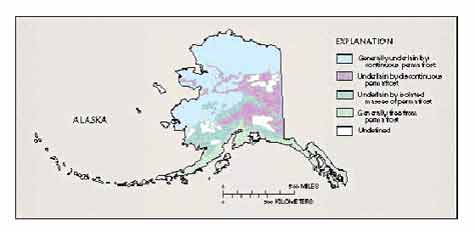
Distribution of permafrost. The solid line shows the approximate southern limit of contemporary permafrost. (www.usarak.army.mil/DPW/Alaska.asp)
Figure 2.
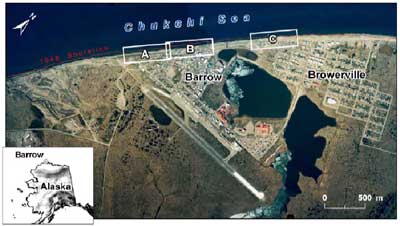
Overview of Barrow
Figure 3.
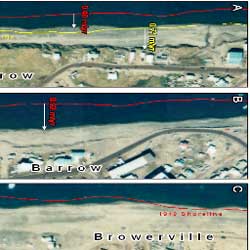
Costal erosions rates in Southwest Barrow and Barrow and the expect return wind increase.
Figure 4.
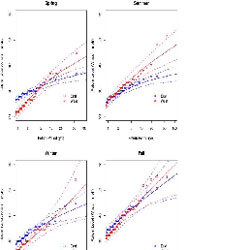
Permafrost upheavals damage roads.
Bibliography
Alda, Alan 2004 "Hot Times in Alaska " Scientific American Frontiers
Armstrong, R. L. (n.d.). State of the Cryosphere. retrieved Nov. 5, 2004, from NSIDC Web site: http://nsidc.org/sotc/permafrost.html.
Berner, Jim, Terry Callaghan, Shari Fox, Etc. "Arctic Climate Impact Assessment Highlights." 2004. http://amap.no/acia/. Arctic Climate Impact Assessment. 3 Dec. 2004 http://amap.no/acia/Highlights.pdf
Canada's Digital Collection, (2004). Glossary. retrieved Dec. 02, 2004, from Alberta, Naturally Web site:
http://collections.ic.gc.ca/abnature/glossary.htm.
"Climate Change and Wildlife" Science and Environment Bulletin, May/June 2002
Maxwell, B. 1997. "Responding to Global Climate Change in the Canada's Arctic," Canada Country Study: Climate Impacts and Adaptation, Volume II.
Egan, T. (2002, June 16). Now, in Alaska, even the permafrost is melting. The New York Times, Retrieved Dec 02, 2004, from http://class.cldstar.com/engl102_spring2004/articles-to-use/alaska-warming/16ALAS.html.
Gas hydrate. (n.d.). retrieved Dec. 03, 2004, from http://www.giscenter.ru/gas/Home/stability.htm.
"Glacier Change in the Upper Skagit River Basin." 26 July 2004.
Glacier Research at Portland State University. Portland State University. 1 Dec. 2004 http://glaciers.pdx.edu/Skagit/Atlas12.html.
"Global Warming Makes Bears Sweat." Planet Save. 03 Dec. 2004 http://www.planetsave.com/ViewStory.asp?ID=3253.
Goldberg, D. (2003, October 21). Climate change and artic impact. Retrieved Dec 03, 2004, from http://www.ciel.org/Climate/Climate_Arctic.html.
Handwerk, B. (2004). Global warming fast facts. retrieved Nov. 8, 2004, from National Geographic News Web site: http://news.nationalgeographic.com/news/2004/12/1206_041206_global_warming.html.
Heidorn, PhD, Keith C. "PERMAFROST: SPECTER OF THE GREAT ICE AGES." Feb. 2001. Weather Alamanac. 6 Nov. 2004 http://www.islandnet.com/~see/weather/almanac/arc2001/alm01feb.htm.
"Ice melting under the Feet of the Polar Bear." 25 Mar. 2002. Our beautiful World. 03 Dec. 2004 http://www.vulkaner.no/n/globwarm/eicebearloss.html.
International Arctic Research Center, (2004). Permafrost/frozen soil models and observations. retrieved Dec. 02, 2004, from http://www.iarc.uaf.edu/projects/permafrost.php.
Impacts of a Warming Arctic. Arctic Climate Impact Assessment, Retrieved Nov. 5, 2004, from www.cambridge.org.
Impacts of permafrost. (n.d.). retrieved Dec. 02, 2004, from http://www.carleton.ca/~msmith2/impacts_on_permafrost.htm.
Kirby, Alex; Warming 'threatens third of habitats' BBC news Wednesday, 30 August, 2000
Koslow, Lelinda http://nome.colorado.edu/HARC/koslow.doc
Nelson, F. (2001, April 19). Subsidence risk from thawing permafrost. Nature, 410. Retrieved ec 02, 2004, from http://www.nature.com/cgi-taf/DynaPage.taf?file=/nature/journal/v410/n6831/abs/410889a0_r.html&dynoptions=
"Permafrost/Frozen Soil Models and Observations." 28 May 2004. International Arctic Research Center. University of Alaska Fairbanks. 16 Dec. 2004 http://www.iarc.uaf.edu/projects/permafrost.
"Reindeer threatened by global warming" December 17, 1996 http://www.wwf-uk.org/
Seifert, Richard. "PERMAFROST A Building Problem in Alaska." April 2001. UAF Cooperative Extension Service. University of Alaska Fairbanks. 2 Dec. 2004 http://www.uaf.edu/coop-ext/publications/freepubs/HCM-00754.pdf.
Stidger, Ruth. "Alaska DOT Deals with Permafrost Thaws." June 2001. Better Roads. 8 Dec. 2004 http://www.betterroads.com/articles/brjun01c.htm.
Sturm, Matthew; Perovich, Donald; and Serreze, Mark. "Meltdown in the North." Scientific America 2003: "The Kyoto Protocol." 30 Sept 2004. BBC News UK edition. BBC News. 2 Dec. 2004 http://news.bbc.co.uk/1/hi/sci/tech/3927813.stm.
"Vanishing seabirds worry Arctic biologists" CBC Health and Science News October 15, 2004
Wohlforth, 2004. The Whale and the Super Computer. On the Northern front of Climate Change.
Woods, Michael. "Atop world, scientists ask why ice cap is melting." 26 Apr 1999. Pittsburgh Post-Gazette. 16 Dec. 2004 http://post-gazette.com/healthscience/19990423ice1.asp.
This page is HTML
4.01 validated. Last modified 19-May-2005. Contact ASG web coordinator.